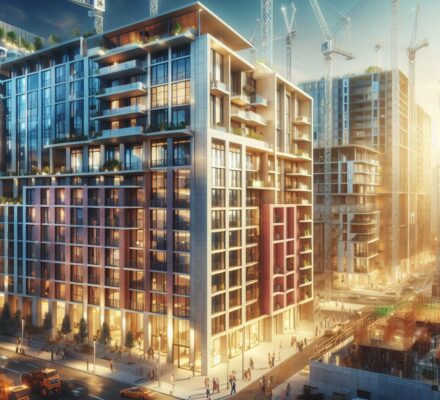Are you ready to take your multifamily investments to the next level?
Discover the power of strategic renovations. By strategically renovating your properties, you can unlock a world of potential and maximize your returns.
From identifying target areas for renovations to budgeting and planning, this article will guide you through the process step-by-step.
With the right renovation strategies in place, you can measure success and watch your investments flourish.
Get ready to boost your multifamily investments through the art of strategic renovations.
Key Takeaways
- Strategic renovations can attract higher-quality tenants.
- Renovations can increase rental income and improve the overall value of the investment.
- Identifying target areas for renovations involves assessing the needs and preferences of tenants, conducting surveys and analyzing feedback, considering the demographic makeup of the tenant population, and researching the local real estate market.
- Budgeting and planning for renovations requires creating a detailed budget and timeline, evaluating the scope of work and associated costs, allocating funds for expected and unexpected expenses, and consulting with experienced professionals for cost estimates.
Benefits of Strategic Renovations
The benefits of strategic renovations can greatly enhance your multifamily investment. By strategically renovating your property, you can attract higher-quality tenants, increase rental income, and ultimately improve the overall value of your investment.
One of the key benefits is the ability to command higher rents. When you invest in upgrades such as modern appliances, updated fixtures, and stylish finishes, you can justify higher rental rates. This not only helps you increase your monthly income but also positions your property as more desirable in the market.
Strategic renovations also allow you to improve tenant satisfaction and retention. By addressing common issues such as outdated interiors, inadequate amenities, or insufficient storage space, you can create a more comfortable living environment for your tenants. This, in turn, leads to higher tenant satisfaction and increased lease renewals. Happy tenants are more likely to take care of the property, reducing maintenance costs and minimizing vacancies.
Furthermore, strategic renovations can positively impact the value of your multifamily investment. Upgrading key areas such as kitchens, bathrooms, and common spaces can significantly increase the property’s market value. Whether you plan to sell the property in the future or refinance to access equity, these improvements will help you maximize your return on investment.
Identifying Target Areas for Renovations
To effectively identify target areas for renovations, consider assessing the specific needs and preferences of your tenants. Conducting surveys, holding focus groups, and analyzing feedback from residents can provide valuable insights into the areas that require improvement. Look for common themes or recurring issues that tenants are facing, such as outdated appliances, worn-out flooring, or inadequate storage space. These are clear indicators of areas that would benefit from renovation.
Another approach is to consider the demographic makeup of your tenant population. Are they primarily young professionals, families, or retirees? Each group may have different priorities when it comes to the amenities and features they desire in their living spaces. For example, young professionals may prioritize modern finishes and technology integration, while families may prioritize larger kitchens and recreational areas for children. By understanding the preferences of your specific tenant base, you can prioritize renovations that will have the greatest impact on their overall satisfaction.
Additionally, it’s important to consider the market demand and trends in the surrounding area. Research the local real estate market and identify any emerging neighborhoods or areas undergoing revitalization. Renovating properties in these target areas can’t only enhance the value of your investment but also attract new tenants and potentially increase rental income.
Budgeting and Planning for Renovations
Start by creating a detailed budget and timeline for your renovation project. Budgeting and planning are crucial steps in ensuring the success of your multifamily investment. Begin by evaluating the scope of work required and determining the costs associated with each aspect of the renovation. Consider factors such as labor, materials, permits, and any unforeseen expenses that may arise during the process.
It is essential to allocate funds for both the expected and unexpected costs to avoid any financial setbacks. Additionally, create a timeline that outlines the different phases of the renovation project, including demolition, construction, and finishing touches. This will help you stay organized and on track throughout the process.
In your budget and timeline, factor in some buffer time and funds to account for any delays or changes that may occur. It’s also wise to consult with contractors or professionals experienced in renovation projects to ensure accurate cost estimates and realistic timelines.
Implementing Effective Renovation Strategies
Now, it’s time to implement effective renovation strategies to maximize your multifamily investment returns. Renovations can greatly enhance the value and appeal of your multifamily property, attracting higher-quality tenants and commanding higher rental rates. However, it’s crucial to approach renovations strategically to ensure the best return on your investment.
Firstly, conduct a thorough market analysis to identify the specific needs and preferences of your target tenant demographic. This will help you prioritize renovations that align with their desires and expectations. Consider factors such as modern amenities, energy efficiency, and updated finishes.
Next, create a detailed renovation plan that includes a clear timeline, budget, and scope of work. This will help you stay organized and prevent unnecessary delays and cost overruns. Break down the renovation project into phases, focusing on high-impact areas such as kitchens, bathrooms, and common areas.
When selecting contractors and suppliers, thoroughly vet their credentials, experience, and track record. Request multiple bids to ensure competitive pricing and quality workmanship. Communicate your expectations clearly and regularly with the renovation team to ensure they understand your vision and goals.
Finally, consider the long-term maintenance and operational costs associated with the renovations. Opt for durable and low-maintenance materials that will minimize future expenses. Regularly evaluate the performance and impact of the renovations to make informed decisions for future improvements.
Measuring the Success of Renovations
Evaluate the impact of your renovations by tracking key performance indicators and analyzing tenant satisfaction. Measuring the success of your multifamily property renovations is crucial to ensure that your investment is yielding the desired results. By implementing a strategic approach to evaluation, you can make informed decisions for future renovations and optimize the returns on your investment.
Consider tracking the following key performance indicators (KPIs) to assess the success of your renovations:
- Occupancy Rate: Monitor the percentage of units that are occupied after the renovations. A higher occupancy rate indicates that your renovations are attracting tenants and increasing demand for your property.
- Rental Income: Compare the rental income before and after the renovations to gauge the financial impact of your improvements. Increased rental income signifies that tenants are willing to pay more for the upgraded living spaces.
- Tenant Satisfaction: Conduct regular surveys or interviews with your tenants to gather feedback on their satisfaction with the renovated units. Their input can provide valuable insights into the effectiveness of your renovations and identify areas for improvement.
Analyzing these KPIs will allow you to identify the areas where your renovations have been successful and areas that may require further attention. By continuously evaluating the impact of your renovations, you can make data-driven decisions to maximize the overall success of your multifamily investments.
Frequently Asked Questions
Are There Any Potential Risks or Drawbacks Associated With Strategic Renovations in Multifamily Investments?
There may be potential risks or drawbacks in strategic renovations for multifamily investments. Consider factors like cost overruns, tenant disruption, and market demand to mitigate these risks and maximize returns.
How Long Does the Renovation Process Typically Take From Start to Finish?
The renovation process typically takes several months, depending on the scope of work. It involves planning, budgeting, hiring contractors, obtaining permits, and overseeing construction. However, the investment in time and effort can yield significant returns.
What Are Some Key Factors to Consider When Selecting Contractors for Multifamily Renovations?
When selecting contractors for multifamily renovations, consider factors such as their experience in similar projects, reputation in the industry, ability to meet deadlines, and cost-effectiveness. These considerations will ensure successful renovations and boost your multifamily investments.
Do Strategic Renovations Have Any Impact on the Overall Property Value and Rental Rates?
Strategic renovations can significantly impact property value and rental rates. By updating amenities, improving curb appeal, and enhancing living spaces, you can attract higher-quality tenants and increase your return on investment.
Are There Any Specific Permits or Regulations That Need to Be Considered When Planning and Executing Multifamily Renovations?
When planning and executing multifamily renovations, you need to consider specific permits and regulations. Understanding and adhering to these requirements will ensure a smooth renovation process and help you avoid costly legal issues.




